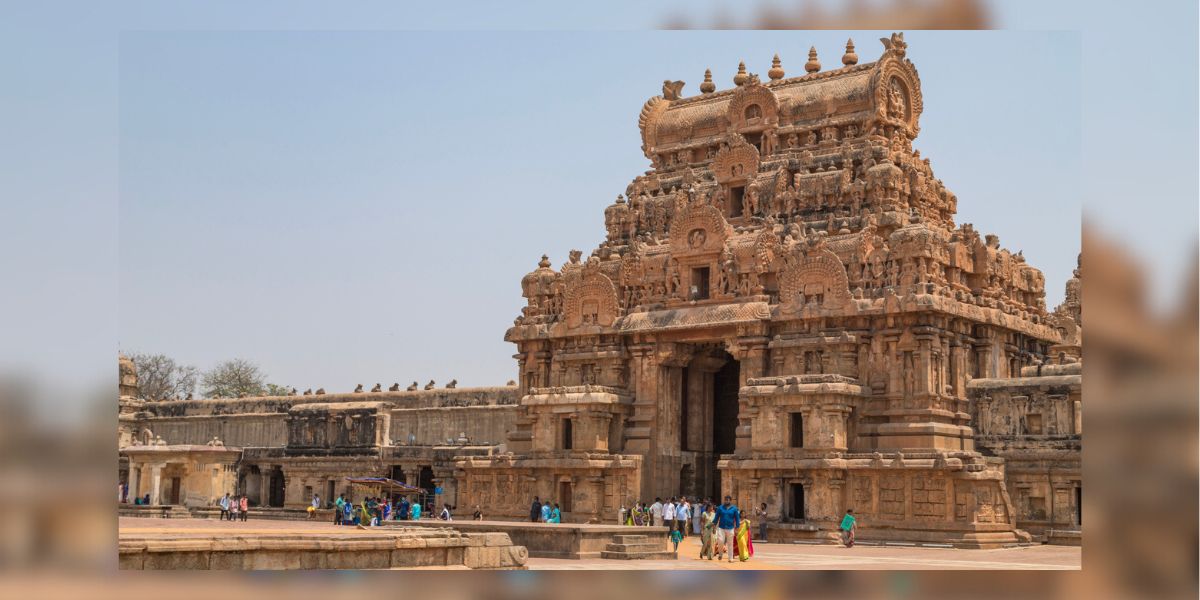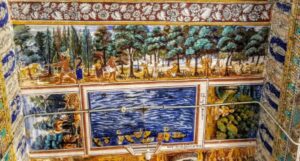Published Nov 25, 2023 | 10:00 AM ⚊ Updated Nov 25, 2023 | 12:25 PM

Tamil Nadu houses four UNESCO World Heritage Sites, 409 sites/monuments with ASI, 85 with State Archaeology plus over 36,000 temples spanning several centuries. (iStock)
The World Heritage Week provides us an opportune moment to delve into the rich cultural tapestry of Tamil Nadu and explore the challenges and triumphs of heritage management.
Home to a plethora of temples, monuments, and traditions that span centuries, Tamil Nadu stands as a testament to the importance of effective heritage conservation.
Tamil Nadu is a treasure trove of monuments. It houses four UNESCO World Heritage Sites, 409 monuments with ASI, 85 sites and monuments with State Archaeology. Besides, it has over 36,000 temples spanning several centuries. The most ancient being the prehistoric sites such as Gudiyam caves and Athirampakkam that is over 300000 years old.
UNESCO World Heritage Sites such as the Brihadeeswarar Temple in Thanjavur (Brihadeesvara Temple, Thanjavur — Google Arts & Culture) being one of the magnificent living Chola temples stands tall for over a 1000 years. It is proof of the architectural mastery of the Cholas.
Their technique of using male and female joints in every block without any mortar keeps us awestruck, as we gaze at the 216 ft tall Vimana – the tallest in South India, in all its resplendent glory.
Inscription records of Brihadeeswarar (Rajarajiswaram) Temple are the evidence of ancient payment systems and labour involved in construction of this grand edifice.
It serves as an important cultural heritage documenting the art, architecture, administrative techniques etc. of the mighty Cholas.
The Kailasanatha Temple at Kanchipuram is one of the earliest structural temples in Tamil Nadu built by the Pallavas. It was restored by ASI (Kailasanatha Temple, Kanchipuram, Tamil Nadu — Google Arts & Culture).
This structure is said to be the precursor for the Dravidian style of temple architecture and has some unique, captivating bas reliefs on the outer walls of the vimana such as Dakshinamurti, Bikshatana and so on.
State Archaeology protected sites such as Kazhugumalai near Kovilpatti (Vettuvankoil, Kazhugumalai — Google Arts & Culture) bear testimony to the incredible skills of the sculptors from the early Pandya kingdom.
The later Jaina bas reliefs are a sight to behold. This historically significant site still remains relatively unknown and deserves more promotion to enable heritage buffs to enjoy its beauty.
Another unique State Archaeology site from the colonial period is Tharangambadi or Tranquebar (Tharangambadi aka Tranquebar — Google Arts & Culture) – a Danish settlement and classic example of best practices for preservation and restoration.
In a rare collaborative effort, the technical expertise of INTACH along with funding from Danish Royalty and Bestseller Foundation have revived a sleepy hamlet and made it a tourist attraction.
Heritage monuments and sites, integral to understanding our culture and traditions, face constant threats, whether from human activities or natural forces.
Rock-cut caves, monuments, and archaeological sites, including precious rock art sites dating back over 3000 years, are particularly vulnerable to vandalism, jeopardizing our legacy.
The demand for living spaces and uncontrolled urban development has led to the destruction of numerous megalithic sites. In addition to these human-made threats, nature also poses a significant risk to monuments.
At Thiruporur near Chennai, burial sites have been impacted by streaming water, resulting in the erosion and dispersal of urns and remains, disrupting their contextual integrity.
Tamil Nadu is home to over 60 sites featuring rare paintings, such as Sittannavasal, Thirupudaimarudhur, Kalakadu, Azhagar Koil and Rangavilasam.
Unfortunately, several temple sites have succumbed to dampness, causing weathering and fading of paintings, leading to their disintegration. Urgent preservation and conservation measures are essential to safeguard these remaining paintings.
Tourism emerges as a crucial ally in preserving and maintaining these sites. Frequent visits by people not only generate revenue but also act as a deterrent to vandalism.
Proper attention and necessary measures can enhance the appeal and accessibility of these sites, making them attractive to a global audience from all corners of the world. However tourists and visitors should be educated about the importance of the monuments and the bad effects of vandalism.
The Government of India and the State Govt. of Tamil Nadu have taken up several measures to preserve these sites and monuments.Many of the temples of historical and architectural value are taken into direct control of Tamil Nadu state department of archaeology and ASI to preserve them for the future.
Many acts like Ancient Archaeological Sites and Remains Act, Monuments Act etc. have been enacted to preserve these heritage treasures and protect them from undue renovations and destruction.
The primary responsibility for safeguarding heritage sites rests with the public and individuals residing in close proximity to these monuments. It is crucial for archaeological and historical organisations to initiate awareness programs, involving local communities in excavation and preservation efforts. These programs not only inform individuals about their cultural heritage but also instill a sense of responsibility for its preservation.

Electrical lines disfiguring Colonial Period Paintings in Konerirajapuram, Thanjavur Dt. (Porchelvi Jeyaprakash)
Preventing destructive actions, such as unauthorised alterations or the use of new stone blocks in the repair of ancient temples, becomes achievable when locals are made aware.
The implementation of awareness initiatives in schools is particularly effective. It helps shape the perspectives of young minds and fosters an understanding of the value of heritage. Organizations like INTACH and Friends of Heritage Sites are actively engaged in awareness programs in the form of seminars, field trips, training and capacity building workshops to bring alive our heritage and legacy.
By instigating such programs, we can cultivate a generation of individuals who are not only aware of the importance of preserving heritage but also actively engaged in its protection. This proactive approach ensures the continuity of heritage conservation efforts, placing the responsibility firmly in the hands of the younger generation, who are poised to become the future guardians of our cultural legacy.
An exemplary instance of innovative conservation technology can be found in Mamallapuram. While the caves were intricately carved into granite, the structural temple presented a distinct challenge.
Due to its proximity to seawater, the temple’s surface faced damage. Continuous deposition of soluble salts from the atmosphere, coupled with fluctuations in atmospheric temperature, resulted in extensive erosion. This jeopardizes the intricate details of the sculptures.
To counteract this threat, a strategic intervention was implemented in 1939. Stone blocks were strategically placed along the shore to shield the monument from direct waves.
Additionally, casuarina trees were planted along the shoreline to mitigate the speed of the wind. This helped to reduce the presence of saline particles in the atmosphere. Despite efforts involving chemical treatments, such as paper pulp applications, the deposits proved challenging to remove. And this resulted in sculptures eroded to the base level.
To maintain the structural stability, various preservation methods were employed. This included the application of lime plasters and the strategic placement of additional stone blocks at necessary points. These preservation measures aimed to safeguard the temple from further deterioration and uphold its historical integrity.
The future management of heritage monuments is a shared responsibility between local communities and the government. Experts must be involved when deep excavations are conducted. They can assess the site thoroughly and issue a certificate confirming that no damage will occur to the heritage remains. This precautionary measure ensures that future archaeological discoveries are not inadvertently concealed beneath structures. The risk of disturbing sites through construction activities is minimized.
The restoration of local temples should be overseen by archaeologists to prevent the inadvertent cementing of valuable inscriptions. Large-scale awareness campaigns should be organized to engage the community in protecting these temples. Drawing inspiration from historical practices where kings donated for the upkeep of temples, a similar model can be implemented today to ensure the sustained vibrancy of these sacred sites.
Embracing technological advancements is crucial for documenting and preserving heritage for future generations. Utilizing 3D modeling and Virtual Reality can bring temples to life, enabling global access to cultural knowledge. Technologies such as Lidar and photogrammetry should be applied to various monuments and sites. Tamil Nadu’s status as a technologically advanced state can be harnessed for these endeavors.
Moreover, advancements in ancient chemical treatment techniques can enhance preservation outcomes while minimizing environmental impact. Though the vast cultural landscape of Tamil Nadu poses a challenge, the unique style of its monuments make the effort worthwhile. The commitment to preserving these treasures ensures that they endure for generations to come.
As Tamil Nadu celebrates its rich cultural heritage during World Heritage Week, the need for effective heritage management is paramount. By addressing challenges, implementing innovative techniques, and fostering collaboration, Tamil Nadu can ensure that its historical tapestry remains intact.

Jul 26, 2024

Jul 24, 2024

Jul 24, 2024

Jul 19, 2024

Jul 18, 2024

Jul 15, 2024